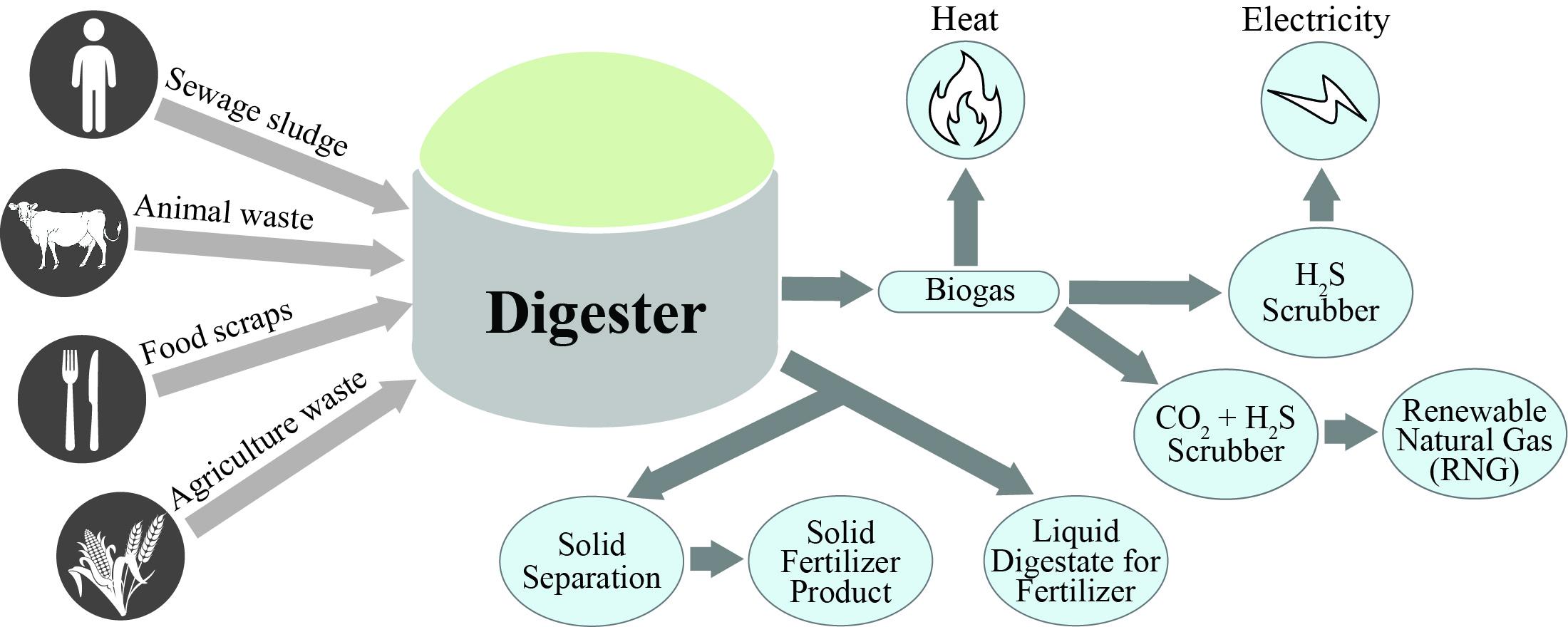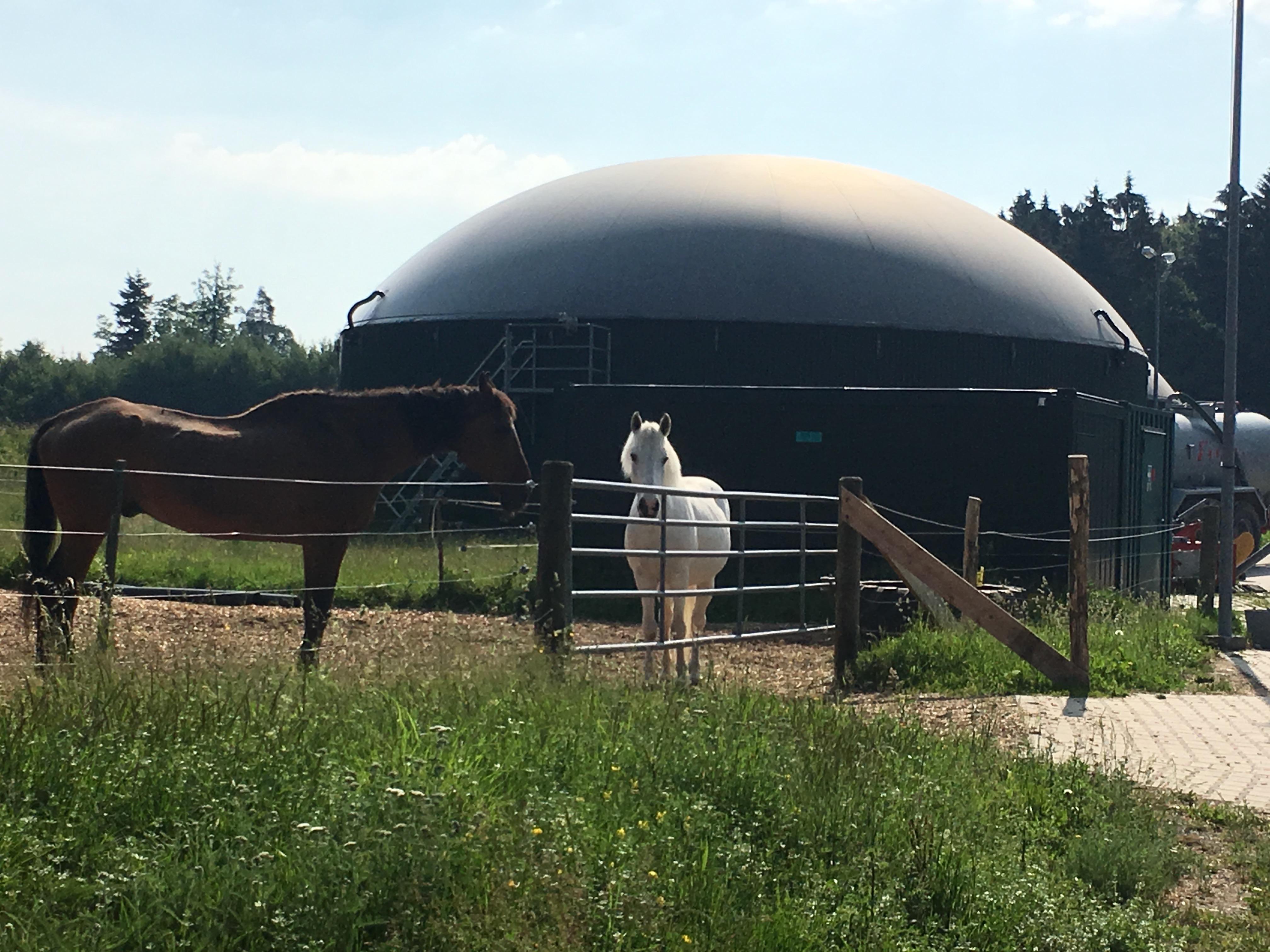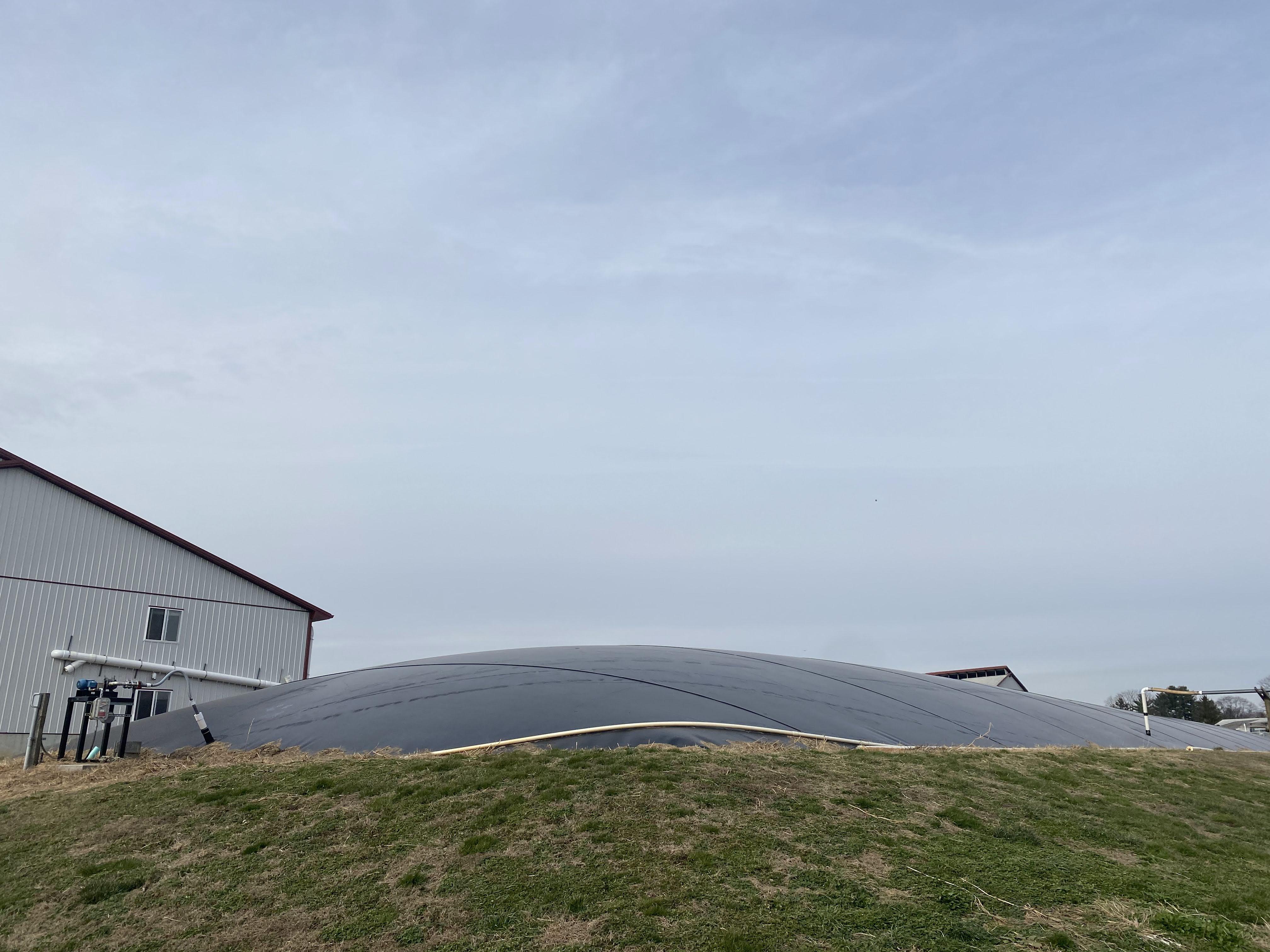
EBR-0686 | February 2024
Anaerobic Digestion

Anaerobic digestion (AD) is a technology that transforms waste into renewable energy while reducing greenhouse gas emissions. During anaerobic digestion, biogas is produced from naturally occurring microbes that break down biodegradable material inside a sealed, oxygen-free reactor called a digester. AD can process a wide range of feedstocks, such as food scraps, manure, crop waste, or sewage sludge. With rising concerns about odors and greenhouse emissions from manure and food waste, the use of AD processing allows farmers to greatly reduce or eliminate these odors and greenhouse gas emissions. Additionally, the AD process produces renewable bioenergy and a fertilizer that is odor-free and pathogen-free, allowing valuable nutrients and organic matter in waste to be used to grow crops and offset the use of chemical-based fertilizers.
Anaerobic digestion involves three biological steps:
- Hydrolysis: Bacteria convert complex materials into soluble carbohydrates, fats, and proteins.
- Acidogenesis: Bacteria convert the soluble compounds into short-chained organic acids.
- Methanogenesis: Bacteria (called methanogens) utilize the organic acids to produce biogas, which has >50% methane.
The process is similar to digestion inside a person’s stomach, where bacteria metabolize our food. The process of anaerobic digestion is sensitive to several variables, including pH, oxygen concentration, and digester temperature. The digester temperature is usually mesophilic (35-38°C or 95-100 °F) or thermophilic (55-60°C or 130-140 °F), the reactor is free of oxygen, and the pH is between 6.8 and 8.

One of the valuable products of AD is biogas. Biogas is the mixture of gases produced by the microbial decomposition of organic wastes in anaerobic digestion systems. It is composed of 50-75% methane (CH₄), 25-50% carbon dioxide (CO₂), 3-4% water vapor, and trace gases (<1%) that may include hydrogen (H₂), ammonia (NH₃), hydrogen sulfide (H₂S), and carbon monoxide (CO).
Methane is the primary energy component in biogas, with the energy content related to the amount of methane it contains. Biogas can be used directly for heat and electricity production (after removing H₂S using H₂S scrubbing technology to protect the broiler or electric generator from corrosion). Biogas may also be upgraded to renewable natural gas (RNG) with >99% CH₄ by adding more advanced scrubbing technologies that remove all other gases present in the biogas.
Source and Renewability:
- Natural gas is a fossil fuel composed of >99% CH₄ extracted from underground fossil fuel reserves. As a finite resource, the underground reserves where it is extracted will eventually be exhausted. It is a non-renewable energy source produced over millions of years.
- Biogas is produced during AD from decomposition of organic waste materials by microbes in the time span of hours or days. AD processing can produce biogas continuously, making it a source of renewable energy from biomass feedstocks. Biogas is primarily composed of CH₄ (>50%) and produced from renewable feedstocks, such as agricultural waste, food scraps, animal waste, and sewage sludge, which can be regenerated within a short time frame.
Carbon Footprint:
- Natural gas is extracted, transported, and burned for energy. Methane is a potent greenhouse gas that can leak during natural gas extraction and transportation. When burned for heating or electricity, the CH₄ in natural gas is transformed into additional atmospheric CO₂ that contributes to global warming.
- Biogas is also burned for heat or electricity production, with CH₄ transformed into CO₂ by the combustion process. When renewable feedstocks, such as food waste and manure, are used in anaerobic digestion, this CO₂ is not additional CO₂ but represents the release of previously sequestered CO₂ during photosynthesis. Avoided CH₄ emissions occur when manure and food scraps are processed in anaerobic digesters. The CH₄ that would have been otherwise naturally formed and released in open lagoons or landfill storage is captured, renewable energy is generated, and global warming potential is significantly reduced.
- Electricity is generated when biogas is combusted to power a generator or a combined heat and power (CHP) system, where the captured heat can also be used to heat the anaerobic digester and meet other nearby heating needs.
- Heat is generated from the direct burning of biogas. It can be used for cooking, industrial processes, or to generate steam.
- Renewable Natural Gas (RNG) is created when biogas is upgraded to >99% CH₄, where the RNG can be injected into a natural gas pipeline or used in any natural gas installation.
- Vehicle Fuel is formed when the biogas is compressed and upgraded (on-farm or at a central location) using advanced CO₂ scrubbing technology to at least 80% CH₄. If the biogas contains 80 - 95% CH₄, a vehicle manufactured to run on upgraded, compressed biogas will be needed. If the biogas is upgraded to >99% CH₄, also known as RNG, any vehicle designed to run on compressed natural gas can be used.

- Electricity, heat, RNG, and vehicle fuel sales can generate revenue based on direct use or sale. The electric sale price can depend on whether the energy is used on-site to offset energy use or sold to an electric or natural gas company, with the rates negotiated between the electric company and the operator based on state law.
- Fertilizers from AD include the effluent that can be used directly as a liquid fertilizer. The solids can also be separated from the liquid fertilizer and sold as a solid fertilizer product, with similar nutritional and soil conditioning benefits to compost. Separated liquids can be used directly on fields as a fertilizer or the nutrients can be extracted from the liquids through advanced processing and sold separately.
- Farmers and/or AD operators can receive tax credits from federal, state, or local sources for renewable electricity or renewable natural gas produced from AD, with rates depending on the relevant federal, state, and local policies.
- Renewable Fuel Standard (RFS) and Renewable Energy Credits (REC) are used in federal and certain state energy trading programs. The RFS and REC values are based on the renewable identification numbers (RINs) given, which take into account the expected greenhouse gas emissions reduced based on the type of biomass feedstock digested.
- AD operators can receive tipping fees from manufacturing, businesses, or entities that generate organic waste and pay AD operators to receive the organic waste and process it using digestion.
- AD operators can receive carbon offset credits as AD processing decreases greenhouse gas emissions by reducing CO₂ and CH₄ emissions. AD systems decrease CH4 emissions by capturing and processing manure or food waste and reduce additional CO₂ emissions through renewable energy production that offsets fossil fuel energy use. AD operators can sell the carbon offset credits through private transactions or credit aggregators.
Anaerobic digestion is a technology that transforms biomass into renewable energy and beneficial fertilizer while reducing odors and greenhouse gas emissions. During anaerobic digestion, biogas is produced from naturally occurring microbes that degrade biomass inside a sealed, oxygen-free reactor, called an anaerobic digester. Anaerobic digesters can process a wide range of waste, such as food scraps, manure, crop waste, or sewage sludge. The products of can provide additional revenue sources to farms through electricity or RNG sales, tipping fees, and/or tax credits.
Contact Information
For more information on the Animal Waste Technology factsheet series and the
Maryland Animal Waste Technology assessment submitted to the Maryland
Department of Agriculture go to https://go.umd.edu/AWTF
Funding
This material is based upon work supported by the Maryland Department of
Agriculture under Grant # MDA-2072-FY22.
AMRO HASSANEIN
STEPHANIE LANSING
slansing@umd.edu
DANIELLE DELP
This publication, Anaerobic Digestion (EBR-2023-0686), is a part of a collection produced by the University of Maryland Extension within the College of Agriculture and Natural Resources.
The information presented has met UME peer-review standards, including internal and external technical review. For help accessing this or any UME publication contact: itaccessibility@umd.edu
For more information on this and other topics, visit the University of Maryland Extension website at extension.umd.edu
University programs, activities, and facilities are available to all without regard to race, color, sex, gender identity or expression, sexual orientation, marital status, age, national origin, political affiliation, physical or mental disability, religion, protected veteran status, genetic information, personal appearance, or any other legally protected class.
When citing this publication, please use the suggested format below:
Hassanein, A., Lansing, S., & Delp, D. (2024). Anaerobic Digestion (EBR-2023- 0686). University of Maryland Extension. go.umd.edu/EBR-2023-0686.
 English
English العربية
العربية Български
Български 简体中文
简体中文 繁體中文
繁體中文 Hrvatski
Hrvatski Čeština
Čeština Dansk
Dansk Nederlands
Nederlands Suomi
Suomi Français
Français Deutsch
Deutsch Ελληνικά
Ελληνικά हिन्दी
हिन्दी Italiano
Italiano 日本語
日本語 한국어
한국어 Norsk bokmål
Norsk bokmål Polski
Polski Português
Português Română
Română Русский
Русский Español
Español Svenska
Svenska Català
Català Filipino
Filipino עִבְרִית
עִבְרִית Bahasa Indonesia
Bahasa Indonesia Latviešu valoda
Latviešu valoda Lietuvių kalba
Lietuvių kalba Српски језик
Српски језик Slovenčina
Slovenčina Slovenščina
Slovenščina Українська
Українська Tiếng Việt
Tiếng Việt Shqip
Shqip Eesti
Eesti Galego
Galego Magyar
Magyar Maltese
Maltese ไทย
ไทย Türkçe
Türkçe فارسی
فارسی Afrikaans
Afrikaans Bahasa Melayu
Bahasa Melayu Kiswahili
Kiswahili Gaeilge
Gaeilge Cymraeg
Cymraeg Беларуская мова
Беларуская мова Íslenska
Íslenska Македонски јазик
Македонски јазик יידיש
יידיש Հայերեն
Հայերեն Azərbaycan dili
Azərbaycan dili Euskara
Euskara ქართული
ქართული Kreyol ayisyen
Kreyol ayisyen اردو
اردو বাংলা
বাংলা Bosanski
Bosanski Cebuano
Cebuano Esperanto
Esperanto ગુજરાતી
ગુજરાતી Harshen Hausa
Harshen Hausa Hmong
Hmong Igbo
Igbo Basa Jawa
Basa Jawa ಕನ್ನಡ
ಕನ್ನಡ ភាសាខ្មែរ
ភាសាខ្មែរ ພາສາລາວ
ພາສາລາວ Latin
Latin Te Reo Māori
Te Reo Māori मराठी
मराठी Монгол
Монгол नेपाली
नेपाली ਪੰਜਾਬੀ
ਪੰਜਾਬੀ Afsoomaali
Afsoomaali தமிழ்
தமிழ் తెలుగు
తెలుగు Yorùbá
Yorùbá Zulu
Zulu ဗမာစာ
ဗမာစာ Chichewa
Chichewa Қазақ тілі
Қазақ тілі Malagasy
Malagasy മലയാളം
മലയാളം සිංහල
සිංහල Sesotho
Sesotho Basa Sunda
Basa Sunda Тоҷикӣ
Тоҷикӣ O‘zbekcha
O‘zbekcha አማርኛ
አማርኛ Corsu
Corsu Ōlelo Hawaiʻi
Ōlelo Hawaiʻi كوردی
كوردی Кыргызча
Кыргызча Lëtzebuergesch
Lëtzebuergesch پښتو
پښتو Samoan
Samoan Gàidhlig
Gàidhlig Shona
Shona سنڌي
سنڌي Frysk
Frysk isiXhosa
isiXhosa